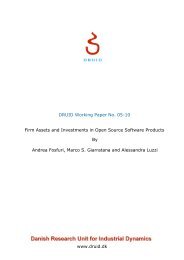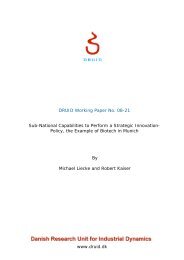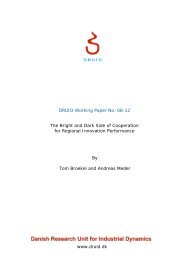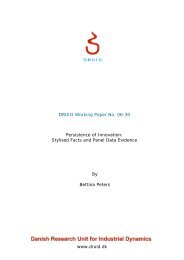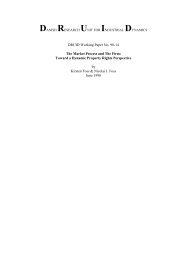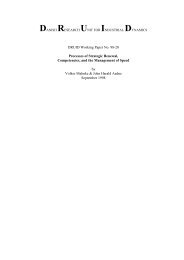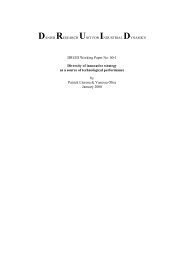danish research unit for industrial dynamics druid working paper no ...
danish research unit for industrial dynamics druid working paper no ...
danish research unit for industrial dynamics druid working paper no ...
You also want an ePaper? Increase the reach of your titles
YUMPU automatically turns print PDFs into web optimized ePapers that Google loves.
112. Dynamics of agreements and production of k<strong>no</strong>wledge: some openquestionsThe aim of our contribution is to try to offer an alternative perspective from transactionscost eco<strong>no</strong>mics (TCE) by focusing on the way problem solving and competence gaps, push<strong>for</strong> the association of dissimilar activities. This point is important <strong>for</strong> explaining thestability and evolution of the T <strong>for</strong>m - "temporary <strong>for</strong>ms" according to Williamson'stermi<strong>no</strong>logy (Williamson, 1995). According to us, the TCE perspective misses twoimportant points <strong>for</strong> the correct understanding of inter-firms relations. As underlined byBrousseau (1996) and Lazaric and Wolff (1996), transactions cost theory falls short ofaccounting <strong>for</strong> institutional <strong>dynamics</strong>, as its perspective is a comparatively static one.Organisational <strong>for</strong>ms are <strong>no</strong>t really examined in their evolution and historical developmentbut compared under the hypothesis that static efficiency properties are sufficient to explaintheir selection.According to us this theoretical background, though indeed very relevant, is <strong>no</strong>t sufficient<strong>for</strong> the analysis of path-dependent processes of organisational adaptation. The very idea ofselecting the most efficient organisational <strong>for</strong>m is rather ambiguous, <strong>for</strong> on the one handboundedly rational agents can hardly be capable of selecting the most efficientorganisational <strong>for</strong>m, and, on the other hand, the capabilities of the market mechanisms <strong>for</strong>per<strong>for</strong>ming such selection has been widely questioned (cf., <strong>for</strong> instance, Winter (1986)).TCE assumes that agents can select ex-ante the best governance structure minimisingtransaction costs (Brousseau, 1996), whereas selection occurs with multiple and nestedselection criteria (e.g. organisational coherence, problem-solving, social interaction,tech<strong>no</strong>logical learning,.... cf. Dosi, 1995).Secondly, learning is described by TCE through the concept of “remediableness” (if agentsselect an inefficient organisational <strong>for</strong>m, they have the possibility of changing it). In ourview, this concept is <strong>no</strong>t sufficient to explain the context of learning embedded i<strong>no</strong>rganisational arrangements (competency trap, organisational inertia, cf. Levinthal, 1992).We argue that learning can<strong>no</strong>t be described only by the minimisation of transactions costsand has to be understood within a perspective of k<strong>no</strong>wledge building, with the possibility of



